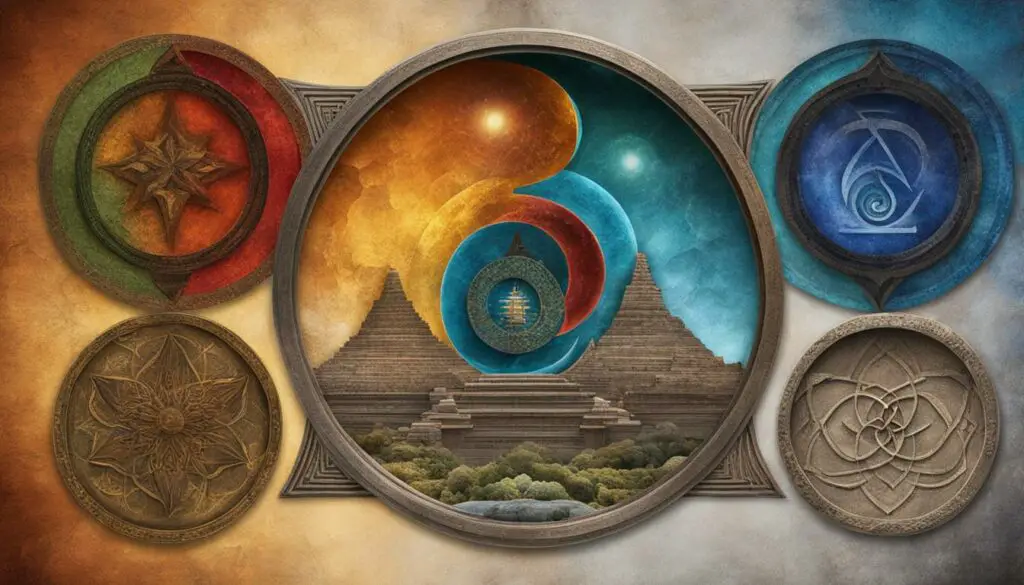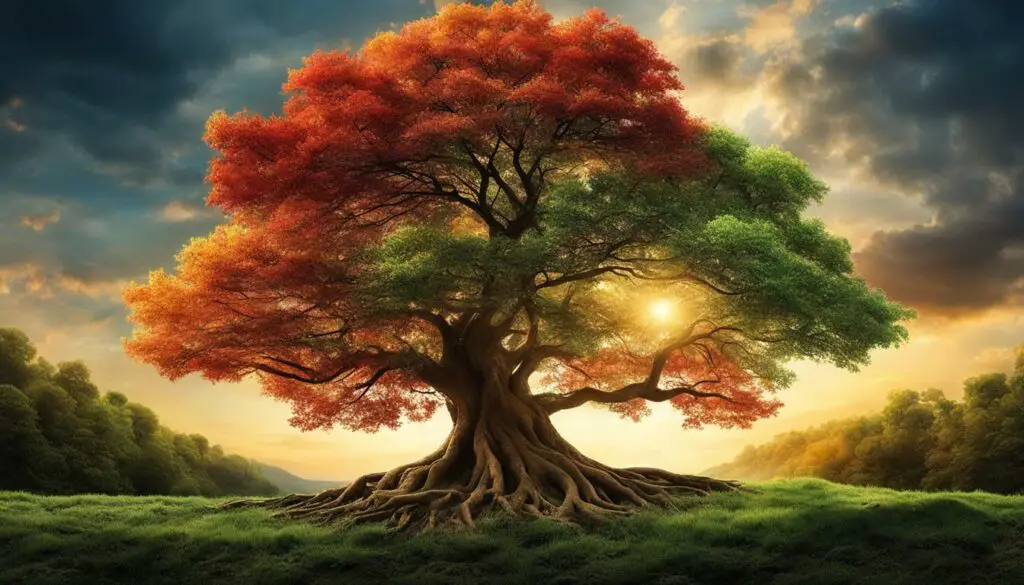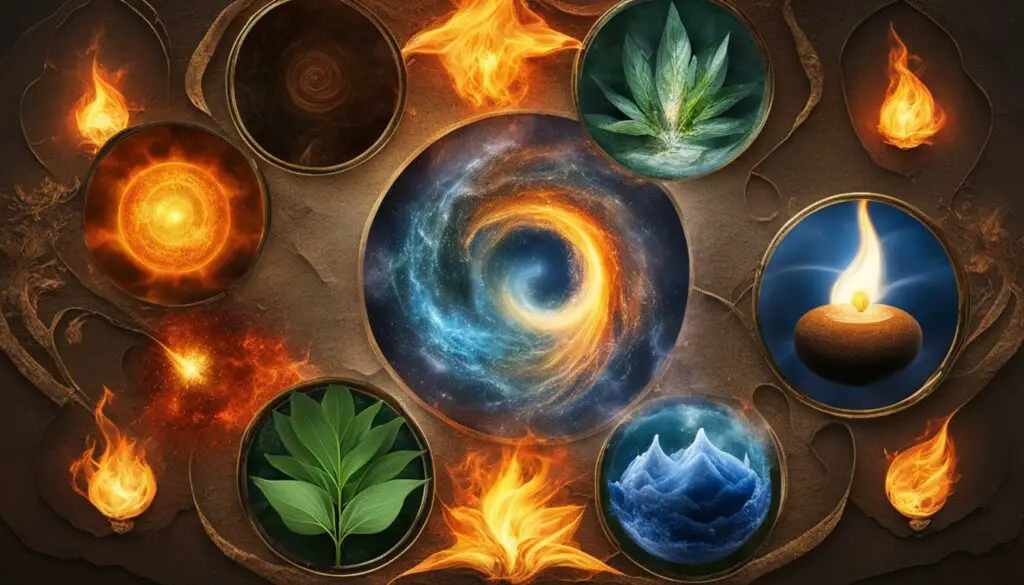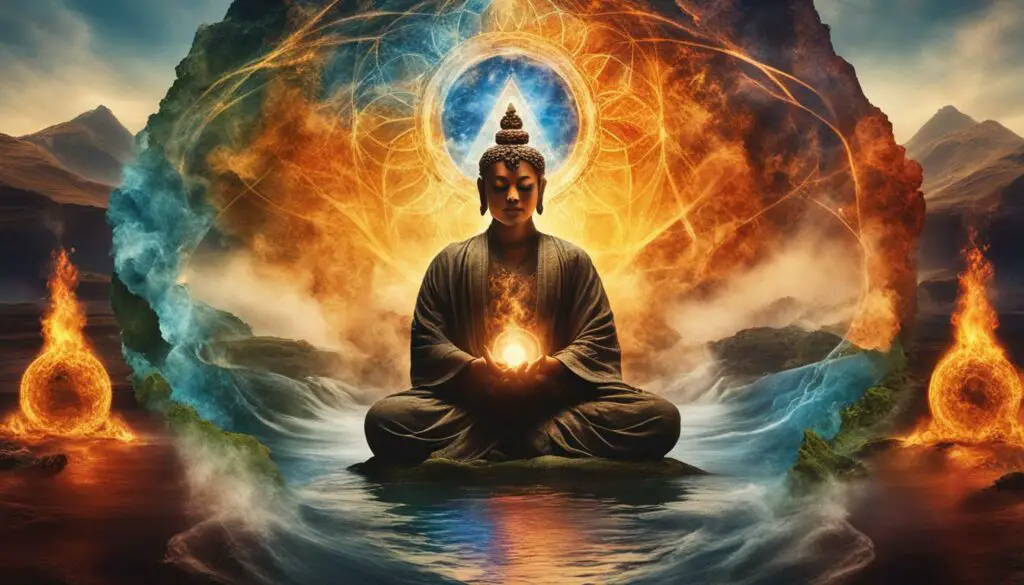Welcome to our comprehensive guide on the 5 elements – earth, water, fire, air, and spirit. These five basic elements hold great significance in nature, ancient philosophy, and our daily lives. In this article, we will explore the qualities, symbolism, and energy of each element, as well as their interconnection and balance. Join us on this journey of discovery as we deepen our understanding of the 5 elements and their role in shaping our existence.
Key Takeaways:
- The 5 elements – earth, water, fire, air, and spirit – are fundamental components of nature and have been studied and revered in ancient philosophy and spirituality.
- Each element has unique qualities and symbolic meanings that influence our lives and experiences.
- The balance and harmony of the 5 elements are crucial to our overall well-being and vitality.
- Through understanding and working with the energy of the 5 elements, we can cultivate a deeper connection to ourselves and the world around us.
- The wisdom of the 5 elements finds relevance in various fields, from design to personal growth, and can be applied in practical ways to enhance our lives.
The Elements in Nature
The 5 elements – earth, water, fire, air, and spirit – are fundamental components that make up the natural world. Let’s explore how each element manifests in nature and examine their unique properties:
Earth
The element of earth is all around us, from the ground beneath our feet to the rocks, crystals, and minerals that make up the earth’s crust. It represents stability, grounding, and physicality, and is associated with the base of the spine in the human body. Earth energy is nurturing and supportive, providing a foundation for growth and transformation.
Water
Water is a powerful and dynamic force in nature, encompassing oceans, rivers, lakes, and rain. It represents fluidity, emotion, and the ebb and flow of life. Water is associated with the sacral chakra in the human body, which governs our emotions and creativity. Its energy is transformative, cleansing, and healing.
Fire
Fire is the element of transformation and passion. It represents the spark of life and the energy of change. Fire can be found in the sun, lightning, and the heat of the earth’s core. It is associated with the solar plexus chakra in the human body, which governs our personal power and inner strength. Its energy is purifying, illuminating, and motivating.
Air
Air is all around us, from the gentle breeze to the raging storm. It represents communication, intellect, and the power of the mind. Air is associated with the throat chakra in the human body, which governs our ability to express ourselves and communicate with others. Its energy is light, refreshing, and invigorating.
Spirit
Spirit is the fifth element that binds all others. It represents the essence of life, the connection between all things, and the divine spark within each of us. Spirit energy is associated with the crown chakra in the human body, which governs our connection to higher consciousness and the universe. Its energy is transcendent, unifying, and eternal.

“Nature is a rich tapestry of interconnected elements.”
By understanding the unique properties and symbolism of the 5 elements, we can gain a deeper appreciation for the natural world and our place within it. Join us as we continue to explore the mysteries of the 5 elements.
Earth: The Foundation Element
When we think of earth, we may envision mountains, forests, or deserts. But this element goes beyond the physical realm, encompassing qualities such as stability, grounding, and nurturing. In ancient philosophies, earth is often associated with the feminine, the material, and the foundational.
Understanding the symbolism of earth can help us connect with its energy and embrace its gifts. Here are some qualities and symbolism associated with the element of earth:
| Elemental Qualities | Symbolism |
|---|---|
| Stability | The solid foundation that supports growth and evolution. |
| Grounding | The ability to stay connected to the earth and find balance amid chaos. |
| Nurturing | The power to provide sustenance and support to all living beings. |
| Materiality | The physical manifestation of our thoughts, dreams, and creations. |
By embracing the symbolism of earth, we can learn to appreciate its role in our lives and cultivate a deeper understanding of ourselves and the world around us. We can also explore ways to incorporate earth energy into our daily routines, such as spending time in nature, gardening, or creating an earth altar in our living space.
As the foundation element, earth serves as a source of strength and stability. By honoring and respecting this element, we can create a solid foundation for our own growth and evolution.

Water: The Fluid Element
Water is a powerful and transformative force that flows through every aspect of our lives. It represents purification, cleansing, and renewal.
As an elemental force, water is closely linked to the emotions and the subconscious mind. It is associated with intuition, healing, and the ebb and flow of life.
The energy of water is fluid and adaptable, yet also powerful and relentless. Just like the tides of the ocean, it can be calm and gentle one moment, and forceful and overwhelming the next.
Symbolism of Water
In many cultures, water is revered as a sacred and life-giving element. It is associated with fertility, abundance, and the cyclical nature of existence. In some belief systems, it is even considered to be the source of all life.
The symbolism of water is often closely tied to its physical properties. Its fluidity and ability to take the shape of its container make it a symbol of adaptability and flexibility. Yet, its power to wear away even the toughest of materials makes it a symbol of strength and perseverance.
Water in the Body

The human body is composed primarily of water, with fluids accounting for approximately 60% of our total body weight. Water plays a critical role in many of our bodily processes, including digestion, circulation, and temperature regulation.
Dehydration can have a significant impact on our overall health and well-being. It can lead to fatigue, headaches, and even more serious complications if left untreated.
Harnessing the Energy of Water
Water is a powerful force that can be harnessed for a variety of purposes. From hydroelectric power to irrigation systems, the energy of water has been put to use in countless ways throughout history.
In terms of personal growth and healing, water can be a powerful tool for purification and renewal. Whether through a relaxing bath or a walk by the ocean, spending time near water can help to calm the mind, soothe the soul, and promote emotional healing.
Conclusion
In conclusion, water is a complex and multifaceted element that holds profound significance in both the natural world and the human experience. By understanding its symbolism, energy, and properties, we can learn to harness its power and use it to promote balance, healing, and personal growth.
Fire: The Enigmatic Element
Fire is a symbol of power, transformation, and destruction. It is one of the most enigmatic and dynamic elements, revered and feared throughout human history for its unpredictable nature.
“Every man must come to terms with fire, and thus conclude that life is not only a pleasure, but also a great and terrible mystery.”
– Carl Jung
In many cultures, fire represents the divine spark that ignites the soul and brings warmth, light, and life. It is associated with passion, creativity, and the will to survive.
Fire is also a force of destruction, capable of consuming everything in its path. It is a reminder of the impermanence and fragility of life, and the need to embrace change and let go of what no longer serves us.
| Symbolism | Qualities |
|---|---|
| Passion | Intensity |
| Creativity | Transformation |
| Destruction | Renewal |

The symbolism of fire can be seen in many ancient myths and rituals. In Greek mythology, Prometheus stole fire from the gods and gave it to humanity, representing the gift of knowledge and civilization. In Hinduism, Agni is the god of fire and a messenger between humans and the divine.
The energy of fire can also be harnessed for personal growth and transformation. Through practices like meditation and visualization, we can connect with the fiery energy within us and channel it towards our goals.
Fire in Tarot
In Tarot, the suit of Wands represents fire and its transformative qualities. The Ace of Wands is a symbol of new beginnings and creative inspiration, while the Ten of Wands can indicate burnout and the need to release burdens.
- Energy: Passionate, transformative, intense
- Color: Red, orange, yellow
- Tarot suit: Wands
Join us as we explore the light and breezy essence of air in the next section.
Air: The Gentle Element
As we continue our exploration of the five elements, we come to air, the gentle and ethereal element that fills our lungs and surrounds us at all times. Air represents movement, communication, and the power of the mind.
In ancient philosophy, air was often associated with the intellect and the breath of life. It is the element that connects us to the divine and the unseen, allowing us to tap into higher levels of consciousness.
Symbolically, air is often represented by birds, butterflies, and other creatures that demonstrate lightness and agility. It also embodies the qualities of clarity, inspiration, and intuition.
One of the key aspects of air is its ability to flow and move freely. We can see this in the winds that shape the land and the currents that carry water throughout the planet. In our lives, air can help us to let go of limiting beliefs and embrace new possibilities.

The Qualities of Air
| Element: | Air |
|---|---|
| Color: | Yellow, white, silver |
| Qualities: | Light, agile, communicative, free-flowing, intuitive, inspirational |
| Associated with: | The intellect, communication, the breath of life, the winds of change |
Air is a powerful force that can help us to break free from limiting thoughts and beliefs. It can inspire us to new heights of creativity and innovation, and it can guide us towards a deeper understanding of ourselves and the world around us.
“The wind is us it gathers and remembers all our voices, then sends them tumbling through the leaves and the fields. The wind is everything in the sky.” -Tim McGraw
Take a moment to connect with the element of air. Breathe deeply and feel the flow of energy within your body. Allow yourself to tap into the powerful and inspiring qualities of air, and see where it takes you.
Spirit: The Fifth Element
Spirit, also known as ether or akasha, is often considered the fifth element, binding together earth, water, fire, and air. In ancient philosophy, the concept of spirit represents the essence of being, the universal consciousness that permeates all things.
Although it is intangible and difficult to define, spirit is believed to embody the qualities of transcendence, interconnectedness, and harmony. It is regarded as a bridge between the physical and spiritual realms, inviting us to explore the deeper dimensions of existence.
In Hinduism, spirit is known as akasha, the cosmic space that holds the infinite potential of the universe. In Chinese philosophy, it is represented by the void, the empty space that allows for all things to come into being.
“Spirituality is not to be learned by flight from the world, or by running away from things, or by turning solitary and going apart from the world. Rather, we must learn an inner solitude wherever or with whomsoever we may be. We must learn to penetrate things and find God there.”
― Meister Eckhart, German theologian and philosopher
The inclusion of the fifth element, spirit, represents a holistic approach to understanding the world and our place in it. It acknowledges the interconnectedness of all things and invites us to cultivate a deeper sense of awareness and consciousness.

As we explore the significance of the 5 elements, it is essential to consider the role of spirit in our lives and our connection to the universe. By embracing the wisdom of the fifth element, we can develop a deeper appreciation for the beauty and complexity of existence and cultivate a more profound sense of harmony and balance within ourselves and the world around us.
Key Takeaways
- Spirit represents the essence of being and is often considered the fifth element.
- The concept of spirit embodies qualities of interconnectedness, transcendence, and harmony.
- Spirit serves as a bridge between the physical and spiritual realms.
- The inclusion of the fifth element represents a holistic approach to understanding the world and our place in it.
Elemental Energy and Harmony
The concept of elemental energy is rooted in ancient philosophy and the understanding of the 5 elements. Each element possesses a unique energy that contributes to the balance and harmony of the natural world and our individual lives. Elemental energy can be harnessed and cultivated to restore equilibrium and promote holistic well-being.
Understanding the 5 elements is crucial in cultivating elemental balance. By recognizing the qualities and symbolism of each element, we can identify areas in our lives where we may be lacking or in excess. For example, if we feel scattered and unfocused, we may need to cultivate more earth energy – stability and grounding – in our daily routines.
Ancient philosophy of the 5 elements teaches us that when the elements are in balance, we experience a sense of harmony and vitality. When one or more elements are out of balance, we may experience physical, emotional, or mental dis-ease. Moving toward balance may involve incorporating practices such as meditation, yoga, or acupuncture, which help to harmonize the flow of elemental energy in the body.

Harmony among the elements can also be maintained through our environment and lifestyle choices. For example, surrounding ourselves with natural elements such as plants or crystals can help to harmonize the energies of a space. Choosing foods and activities that align with the qualities of the elements can also contribute to overall balance and well-being.
When we cultivate balance among the 5 elements, we create a foundation for optimal health and vitality. We are able to move through the world with greater ease and grace, and experience a deeper connection to the natural world and ourselves.
The Symbolism of the 5 Elements
As we have explored in previous sections, understanding the 5 elements is key to gaining insight into the balance and harmony of nature and our world. However, the 5 elements also hold symbolic meaning and significance across cultures and belief systems. Let’s take a closer look at what each of the elements represents:
| Element | Symbolic Meaning |
|---|---|
| Earth | Stability, groundedness, foundation, materiality |
| Water | Fluidity, adaptability, flow, transformation |
| Fire | Energy, passion, power, illumination |
| Air | Expansion, lightness, communication, breath |
| Spirit | Connection, transcendence, unity, divine consciousness |
It is important to note that while these symbolic meanings are commonly attributed to the elements, they may differ depending on cultural and personal interpretations. Additionally, the 5 elements may hold different symbolic value within specific contexts, such as astrology or feng shui.
“The Five Elements are pure. They contain no impurities. They cannot be described as moving, not moving, moving and not moving, or not moving and moving.” – Yellow Emperor’s Classic of Medicine
The above quote from the Yellow Emperor’s Classic of Medicine emphasizes the purity and elemental essence of the 5 elements, which can take on different qualities and properties depending on their interactions with each other and the world around them. This concept underlines the importance of understanding the 5 elements in their entirety and as a cohesive system.
Next, we will explore the ancient philosophies surrounding the 5 elements and how they have shaped our understanding of the world.
Exploring Ancient Philosophy
Ancient civilizations have long recognized the importance of the 5 elements in both the natural world and human experience. From the Greeks and the Chinese to the Native Americans and the Hindus, the 5 elements have been a significant part of philosophical and spiritual teachings.
The Greeks believed that everything in the universe was made up of earth, water, air, fire, and ether (or spirit). These elements were seen as the building blocks of life and formed the foundation of their medical and philosophical understanding.
In Chinese philosophy, the concept of Wu Xing, also known as the Five Phases or the Five Agents, describes the cyclical interactions and transformations of the 5 elements. Each element is associated with a specific organ, body tissue, emotion, and season, and is believed to have a profound influence on health and well-being.

The Native Americans viewed the 5 elements as sacred and believed that they were integral to the balance and harmony of nature. Each element was associated with a specific direction, color, and animal, and was believed to hold unique and powerful energy.
Hindu philosophy recognizes the 5 elements as Pancha Bhutas and views them as essential for physical and spiritual balance. Each element is associated with a specific sense organ, chakra, and deity, and is believed to embody different qualities and energies.
The Wisdom of the Ancients
The ancient philosophies surrounding the 5 elements offer a wealth of wisdom and insight into the natural world and the human experience. By studying these teachings, we can gain a deeper understanding of ourselves and our place in the world.
Whether we look to the Greeks, the Chinese, the Native Americans, or the Hindus, the message is clear: the 5 elements are an integral part of our existence and hold profound significance in our lives. By embracing their wisdom, we can cultivate a deeper connection to the world around us and achieve greater harmony and balance.
Cultivating Elemental Balance
Now that we have explored the significance of the 5 elements and their energetic qualities, let’s dive into practical ways to cultivate balance and harmony among them.
One way to start is by assessing which elements are dominant in your life and which ones you may be lacking. This can be done through meditation or self-reflection.
For example, if you feel scattered and ungrounded, you may need more earth energy in your life. Try incorporating grounding practices such as walking barefoot on the earth, gardening, or spending time in nature.
If you feel emotionally closed off or stagnant, you may need to invite more water energy into your life. Take a relaxing bath, try swimming, or simply drink more water.
Additionally, incorporating elemental rituals and practices into your daily routine can help promote balance and harmony. For example, lighting a candle (fire) during meditation or practicing deep breathing exercises (air) can help bring more awareness and balance to your energetic body.
Remember, cultivating elemental balance is a journey, not a destination. Take time to experiment with different practices and techniques to find what works best for you.
Practical Tips:
- Assess which elements are dominant in your life and which ones you may be lacking.
- Incorporate grounding practices to invite more earth energy into your life.
- Take a relaxing bath or try swimming to invite more water energy into your life.
- Practice deep breathing exercises or light a candle to promote balance and harmony.

The Role of the 5 Elements in Healing
The concept of the 5 elements has been incorporated into various healing modalities for centuries. The ancient wisdom of earth, water, fire, air, and spirit offers valuable insights into the human experience and can be harnessed to promote holistic well-being.
Understanding the 5 elements: Each element is associated with specific qualities and energies that can impact physical, emotional, and spiritual health. By understanding the properties of each element, we can identify imbalances and work towards restoration.
Elemental Energy: Elemental energy is believed to flow through the body and impact various organs and systems. Harmonizing this energy through practices like acupuncture, acupressure, or reiki can help to balance the body’s natural rhythms and support healing.
Examples of Elemental Healing:
| Element | Healing Modality |
|---|---|
| Earth | Herbalism, Grounding Practices, Massage, Yoga |
| Water | Aromatherapy, Hydrotherapy, Sound Healing, Meditation |
| Fire | Sweat Lodge, Breathwork, Chanting, Firewalking |
| Air | Breathwork, Pranayama, Reiki, Tai Chi |
| Spirit | Meditation, Prayer, Shamanic Healing, Dreamwork |
When working with the 5 elements in a healing context, it’s important to approach them with respect and reverence. Their power and symbolism offer a gateway to deeper understanding and a profound connection with the natural world and ourselves.

Whether through the practices of traditional Chinese medicine, Ayurveda, or indigenous wisdom, incorporating the 5 elements into our healing journey can offer transformative benefits. By embracing the power of earth, water, fire, air, and spirit, we can tap into the healing potential of nature and foster a sense of balance and well-being in our lives.
Modern Applications of Elemental Wisdom
While the concept of the 5 elements is rooted in ancient philosophy, it has practical applications in the modern world. From design to psychology, the wisdom of the elements continues to inspire and inform contemporary practices. By understanding the elemental energy that flows through all aspects of life, we can tap into a deeper sense of harmony and well-being.
The Role of Elemental Energy in Design
Designers and artists have long been inspired by the natural world, and the 5 elements offer a rich source of creative inspiration. Earthy hues, watery textures, fiery motifs, and airy silhouettes can all be used to evoke a particular energy or mood. In web design, for example, the use of color, space, and typography can reflect the elemental balance of a brand or product.
| Element | Color | Texture |
|---|---|---|
| Earth | Earthy tones: brown, green, beige | Rustic textures: wood, stone, clay |
| Water | Cool tones: blue, turquoise, green | Flowing textures: waves, ripples, drops |
| Fire | Warm tones: red, orange, yellow | Lively textures: flames, sparks, rays |
| Air | Light tones: white, pastels, gray | Breezy textures: clouds, feathers, leaves |
Ultimately, the use of elemental symbolism in design can enhance the user experience and reinforce the brand’s message and values. By incorporating natural elements into our surroundings, we can also create a sense of calm and tranquility in our daily lives.
Connecting with Elemental Energy in Psychology
Psychology also recognizes the role of elemental energy in our emotional and mental well-being. The 5 elements can serve as a framework for understanding and addressing various aspects of the human experience. For example:
- Earth: grounding, stability, physical wellness
- Water: emotional intelligence, intuition, creativity
- Fire: self-confidence, assertiveness, passion
- Air: mental clarity, communication, social intelligence
- Spirit: connection to higher self, purpose, meaning
By identifying our elemental strengths and weaknesses, we can develop strategies to cultivate balance and well-being. This can involve practices such as meditation, breathwork, or yoga, which help us connect with the elemental forces within and around us.
Exploring Elemental Energy in Personal Growth
The wisdom of the 5 elements can also be applied to personal growth and self-discovery. By aligning with the energy of each element, we can deepen our understanding of ourselves and the world.
For example, if we feel stuck or stagnant in our lives, we may need to focus on cultivating the grounding and stability of the earth element. If we feel overwhelmed or emotionally drained, we may benefit from connecting with the nurturing and intuitive energy of water.
Ultimately, the elemental energy that flows through us and around us can serve as a guide for our personal growth and evolution. By embracing the wisdom of the elements, we can tap into a deeper sense of purpose and fulfillment.

Embracing Elemental Consciousness
Connecting with the 5 elements can help us cultivate a deeper understanding of ourselves and the world around us. By embracing elemental consciousness, we can tap into a wellspring of wisdom and insight that can guide us on our journey towards self-discovery and personal growth.
One way to connect with the elements is through meditation and visualization. Try sitting in a quiet place and visualizing each element, one at a time. Engage your senses and imagine the qualities and energy of each element flowing through you.
Another way to honor the elements is through ritual and ceremony. Create a sacred space and set up an altar with items that represent each element. Light candles, burn incense, and offer prayers or blessings to each element.
Remember, the elements are not just external forces – they exist within us as well. By cultivating balance and harmony among the 5 elements within ourselves, we can achieve a greater sense of well-being and vitality.

“The elements are the foundation of all life. By connecting with them, we can deepen our awareness and connection to the world around us.”
The Power of Elemental Affirmations
Affirmations are positive statements that can help shift our mindset and energy towards a desired outcome. Incorporating elemental affirmations into our daily practice can be a powerful way to connect with the 5 elements and harness their energy.
| Element | Affirmation |
|---|---|
| Earth | I am grounded and stable. My foundation is strong. |
| Water | I flow with ease and grace. My emotions are fluid and transformative. |
| Fire | I radiate strength and vitality. My passion and energy fuel my actions. |
| Air | I am light and free. My thoughts and ideas are limitless. |
| Spirit | I am connected to all that is. My intuition guides me towards higher truth. |
Repeat these affirmations to yourself daily, either silently or out loud, and allow their energy to infuse your thoughts and actions.
Embracing elemental consciousness is a powerful way to deepen our connection to the natural world and the universal forces that shape our lives. By tapping into the energy of the 5 elements, we can gain greater clarity, insight, and harmony in all aspects of our existence.
The Power of Elemental Rituals
Elemental rituals can be a powerful way to connect with the energy of the 5 elements and create meaningful experiences. These rituals can range from simple practices like burning candles or diffusing essential oils to more elaborate ceremonies that involve chanting, drumming, or dancing.
Regardless of the form they take, elemental rituals can help us tap into the essence of the elements and use their energy to promote healing, balance, and growth. Here are a few examples of elemental rituals:
- Earth: Create a simple altar with crystals, plants, and other natural materials. Spend time in nature, working with the soil and connecting with the earth.
- Water: Take a ritual bath with essential oils, sea salt, and flower petals. Spend time near a body of water, letting the sound of the waves or flowing water calm and soothe you.
- Fire: Light candles or a bonfire to mark a special occasion or intention. Practice candle gazing meditation to focus your mind and boost your energy.
- Air: Burn incense or diffuse essential oils to purify the air and create a sacred space. Practice deep breathing exercises or spend time outdoors in the fresh air.
- Spirit: Meditate or pray to connect with the divine. Use affirmations or positive self-talk to cultivate a sense of inner peace and faith.
These are just a few examples of elemental rituals. Experiment with different practices and find what resonates with you. Remember that these rituals are a way to connect with your inner self and the world around you, so follow your intuition and let the energy of the elements guide you.

“When we tap into the essence of the elements, we can use their energy to promote healing, balance, and growth.”
Conclusion
The 5 elements – earth, water, fire, air, and spirit – hold a profound significance in nature, ancient philosophies, and our daily lives. By understanding their qualities, symbolism, and energy, we can cultivate harmony, balance, and a deeper connection to the world around us.
From the foundation of earth to the ethereal realm of spirit, each element offers its own unique gifts and teachings. Exploring the ancient philosophy of the 5 elements can provide insight into the wisdom and teachings of ancient civilizations.
Understanding elemental energy can help us cultivate balance and harmony in our daily lives, contributing to overall well-being and vitality. The symbolism embedded within the 5 elements offers a rich tapestry of interpretations that can be observed in various cultures and belief systems around the world.
From practical techniques to cultivate balance to the power of elemental rituals, there are numerous ways to connect with the energy of the 5 elements in our modern world. Embracing elemental consciousness offers the opportunity to connect with and honor the elements in our daily lives, deepening our understanding of their significance.
Join us on this journey of exploration and embrace the wisdom of the elements. Discover how the 5 elements hold relevance in our modern world and how we can harness their energy to promote healing, growth, and holistic well-being.
FAQ
What are the 5 elements?
The 5 elements are earth, water, fire, air, and spirit.
How do the elements manifest in nature?
The elements manifest in nature through earth, water, fire, air, and the ethereal realm of spirit.
What is the significance of the element of earth?
Earth represents stability, grounding, and physicality.
What are the properties of water?
Water is soothing, transformative, and fluid.
What is the energy of fire?
Fire embodies powerful symbolism and transformative energy.
What are the qualities of the element of air?
Air is light, breezy, and permeates our lives through the breath and winds.
What is the fifth element, spirit?
Spirit is the ethereal element that binds all others and has significance in ancient philosophies.
How do the 5 elements contribute to overall well-being?
The balance and harmony of the 5 elements contribute to overall well-being and vitality.
What are the symbolic meanings of the 5 elements?
The 5 elements hold symbolic meanings that are interpreted in various cultures and belief systems.
What ancient philosophies revolve around the 5 elements?
The 5 elements are central to ancient philosophies and hold wisdom and teachings of ancient civilizations.
How can balance among the 5 elements be cultivated?
Balance among the 5 elements can be cultivated through practical daily life practices and techniques.
How do the 5 elements play a role in healing?
The 5 elements play a role in various healing modalities and can be harnessed to restore balance and promote well-being.
How does the wisdom of the 5 elements find relevance in the modern world?
The ancient wisdom of the 5 elements finds relevance in fields such as design, psychology, and personal growth.
How can I connect with and honor the 5 elements in my daily life?
There are various ways to connect with and honor the 5 elements through elemental consciousness practices.
What is the power of elemental rituals?
Elemental rituals and ceremonies have transformative power and help align with the energy of the 5 elements.
